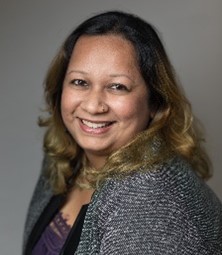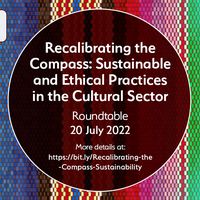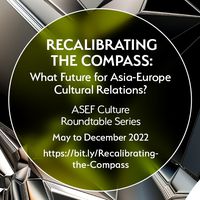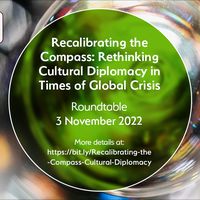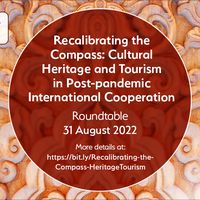Recalibrating the Compass: Culture’s Role in Addressing the Climate Crisis – Roundtable #2 - Report
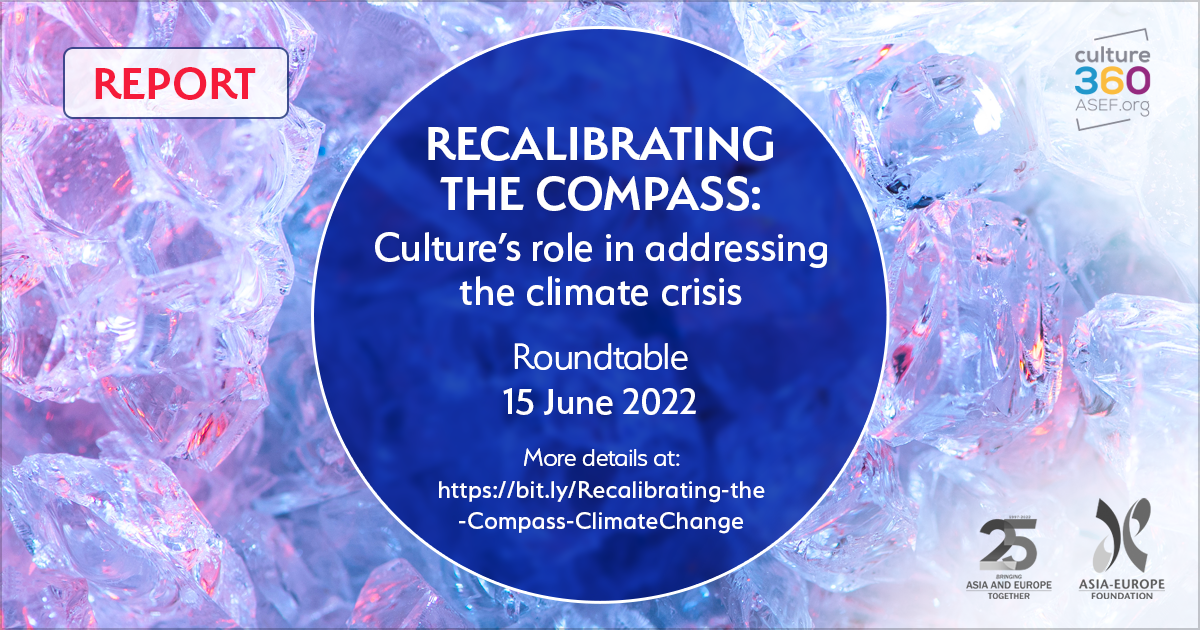
In 2022, on the occasion of the 25th anniversary of the Asia-Europe Foundation (ASEF) and following the global impact of the Covid-19 pandemic, ASEF has launched a series of online roundtables entitled Recalibrating the Compass: What Future for Asia-Europe Cultural Relations? The series aims to examine current challenges and identify ways to develop new, more relevant and resilient forms of support for Asia-Europe cultural collaboration.
The second roundtable, Recalibrating the Compass: Culture’s Role in Addressing the Climate Crisis, took place on 15 June, gathering 8 professionals from across Asia and Europe. Facilitated by Sharmilla Ganesan (Producer and presenter, BFM 89.9 – The Business Station, Malaysia), the roundtable focused on the specific contribution that the culture sector can make to the climate crisis, and its responsibilities vis-à-vis this context. Participants discussed, among other issues, the creative explorations of sustainable living, the responsibilities of cultural organisations and their environmental impact, what sustainability means in terms of cultural mobility and the types of policies, partnerships and forms of cross-regional collaboration that can enable cultural organisations and professionals to be better prepared to act in this context. This short report outlines the main issues discussed during the session.

Creative practice can foster thinking around climate change and the search for solutions.
Throughout the session, several examples that illustrate how artistic practices can contribute to reflecting on the climate crisis and more environmentally sustainable ways of life, as well as raising awareness on these themes, were presented. Among them was Singaporean artist Robert Zhao’s short film Second Chance, produced in the context of the National Museum of Singapore’s Rooting for Change – Artistic Responses to Climate Change and Sustainability programme. The film explains how ‘secondary forests’, that is, those that have emerged in the recent past and which have often been undervalued by researchers, are more resilient to human contact, and therefore can provide a ‘second chance’ in the face of climate change and biodiversity loss.
Another relevant example is What Comes After, a participatory performance developed by artists Jevon Chandra, Kei Franklin and Jungsuh Sue Lim in Chiang Mai, Thailand, which immersed participants in the tumult of a flood. In many locations, artists are exploring ways to develop more sustainable artistic practice and to think creatively about the future – the Future Materials Bank of the Jan van Eyck Academie in the Netherlands, stands as a global repository of these efforts, and helps provide resources and inspiration to others.
We need to question ourselves and our practices…
Professionals and organisations in the cultural and creative sectors, just as those in other fields, are increasingly revising their practices to make them more sustainable and adapted to the climate crisis – questioning their choices, aiming to have more efficient and ‘circular’ buildings and events, considering their investments, interrogating public procurement, etc. The work done by organisations such as Julie’s Bicycle, including its resource hub, provides extensive evidence of this. Many local examples of this exist as well, such as the ufaFabrik cultural complex in Berlin, which has adopted many measures, involving community collaborations and affordable investment, to reduce its environmental footprint and become more sustainable. Elsewhere, efforts are underway to make the cross-border mobility of artists and cultural professionals more sustainable, through ‘slower’ travel and new forms of artistic residencies.
… but to do it with fairness and balance, looking at the big picture
At the same time, participants warned that the burden of responsibility to change should not be placed unfairly on the shoulders of those who are more disadvantaged. The sense of guilt experienced by a group of Indigenous artists who attended the Stockholm+50 environmental conference in early June 2022, because of the carbon footprint of flying on a plane, was illustrative of this – it was suggested that governments and major companies have a significantly more important responsibility vis-à-vis climate change. Likewise, it is necessary to acknowledge that international artistic mobility is frequently framed by socioeconomic and political inequalities. This was highlighted in Mexican artist Lázaro Gabino Rodríguez’s Open Letter to French choreographer Jérôme Bel, which stresses that many artists do not have a choice on whether or not to be mobile, as opposed to high-profile figures.
The notion of ‘climate justice’, which entails considering everyone’s specific situations, being fair in the type of restrictions imposed, and avoiding excluding further those who are already marginalised, is useful in this respect. Indeed, it is necessary to adopt a ‘climate justice lens’. Julie’s Bicycle’s Creative Climate Justice Hub can be an inspiring source of information and ideas in this respect.
Cross-disciplinary creative research can explore climate change in its broader context
Just as it is necessary to consider broader social, economic and international inequalities when taking action, contemporary reflections on climate change also serve to stress how the environmental crisis is closely connected to economic models and historical inequalities. Several participants explained how, across Asia, colonialism has historically intermingled with the conquest and destruction of landscapes, as Listen to the City’s forthcoming Disturbants of land, breath, sound: Aesthetics of Post-colonial culture seminar exhibition emphasises (Seoul, December 2022). This is one of several examples illustrating the rich contribution that cross-disciplinary research involving artists and professionals in other areas can make. The Land Body Ecologies interdisciplinary research network, which explores the interconnections of mental and ecosystem health, involving artist-led studio Invisible Flock among other partners, is another good example of this. All of this requires developing cross-disciplinary and cross-sectorial collaborations, which provide space for experimentation, connecting biodiversity and cultural diversity and which, in so doing, also consider social and climate justice.
Time is needed to develop relevant approaches
Because of the complexity of the issues raised and the need to involve many stakeholders, long-term processes enabling good quality consultations, trust-building, in-depth understanding and collective project design are needed. This is exemplified in the Kala Chaupal Trust’s Bulandshahr Legacy project in Uttar Pradesh, India, which invites cultural practitioners to help communities reappropriate spaces in valuable natural areas which have been threatened by human action. Doing this implies broadening the conversation to everyone, including less represented voices such as (depending on the context where the project is being implemented) Indigenous peoples, minority groups, freelance artists, young and elderly people, etc. To ensure diversity, in some cases it may be necessary to pay participants in consultations for the time they devote.
Mutual trust and in-depth conversations enabled by quality time are also important when fostering international collaboration, as illustrated by the pilot initiative International Touring and Environmental Responsibility. Developed by the Danish Arts Foundation and Arts Council England, in partnership with Julie’s Bicycle among others, it connected arts organisations in Denmark and England, combining training, mutual knowledge sharing and the design of innovative projects.
Suitable mediators and intermediaries are also necessary
To connect the arts and the climate crisis, capacity building is necessary and requires time. Making creative research accessible to the broader public can also require involving mediators and intermediaries who can present the results of artistic work in a language that is accessible and comprehensible to non-specialists. Platforms, foundations, universities, NGOs and communication professionals may be good allies in this respect.
Getting a seat at the negotiating table
Ultimately, many projects connecting culture and the climate crisis aim to influence policymaking, but this is often a challenge in actual practice. Participants considered how the alternative narratives generated through cultural knowledge and creative explorations could be presented to authorities. One important enabling factor lies in conducting good quality artistic documentation of specific places, and the stories that they can tell. When combined with research in other disciplines and presented in the form of comprehensive analysis, this can be a tool to lobby and dialogue with institutions, as well as to connect stories from different places. The example of the ArtCOP21 festival organised by COAL and Cape Farewell in the context of the COP21 climate conference in 2015 in Paris is a success story in this sense.
Opportunities through international collaboration
The global nature of the climate crisis means that there is an obvious ground for cross-border collaborations. This issue has been addressed by many regional and global networks, as well as many collaboration projects. The British Council’s Climate Connection programme, which brings together people around the world to discuss and act on climate change, is an illustrative example, as are the many projects on environmental sustainability funded under the European Commission’s Creative Europe programme. In addition to enabling knowledge exchange and joint projects, international pressure can also serve to make national governments more attentive to environmental issues, as some participants suggested.

The 2nd roundtable in the series Recalibrating the Compass provided the participants with a rich discussion, full of ideas and examples, representing just a small share of the many organisations and projects that are exploring the roles of the arts and culture in addressing the climate crisis. The series will continue with 3 new sessions between July and October and will culminate in a public webinar, where findings and recommendations from all sessions will be shared and discussed.
For more information about the series: https://bit.ly/Recalibrating-the-Compass
For the highlights of Roundtable #2: https://bit.ly/Recalibrating-the-Compass-CreativeEcosystem
ASEF would like to thank the following participants for their valuable contributions to Roundtable #2 – Culture’s Role in Addressing the Climate Crisis:
| Sharmilla GANESAN - FACILITATOR | |||||
 | Alecia NEO |  | Eunseon PARK | |||
 | Leenika JACOB | 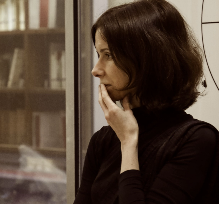 | Marie LE SOURD | |||
 | Rebecca HAZLEWOOD | 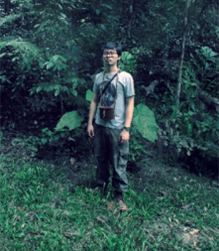 | Robert ZHAO | |||
 | Tiffany FUKUMA | 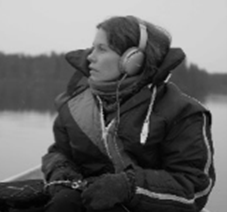 | Victoria PRATT | |||
 | Preeti GAONKAR - ASEF Senior Project Manager Asia-Europe Foundation (ASEF) Culture Department |
| Valentina RICCARDI - ASEF Acting Director Asia-Europe Foundation (ASEF) Culture Department | |||
| ||||||
Similar content
from - to
15 Jun 2022 - 15 Jun 2022
from - to
03 Nov 2022 - 03 Nov 2022
posted on
06 Dec 2022

